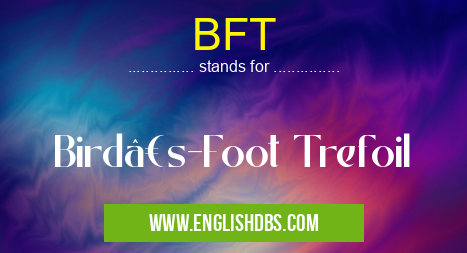What does BFT mean in BOTANY
BFT stands for Bird's-Foot Trefoil, a type of plant belonging to the Lotus genus of the Fabaceae (pea) family. It is commonly found in pastures and meadows, and is characterized by its unique, bird's-foot-shaped leaflets.

BFT meaning in Botany in Academic & Science
BFT mostly used in an acronym Botany in Category Academic & Science that means Bird’s-Foot Trefoil
Shorthand: BFT,
Full Form: Bird’s-Foot Trefoil
For more information of "Bird’s-Foot Trefoil", see the section below.
Uses of BFT
-
Forage: BFT is a highly nutritious forage for livestock, particularly sheep and cattle. It is rich in protein and minerals, and its palatability makes it a desirable grazing option.
-
Soil Improvement: BFT has the ability to fix nitrogen in the soil, which improves soil fertility. Its deep root system also helps to prevent soil erosion.
-
Erosion Control: BFT is often planted on slopes and embankments to control erosion. Its dense growth and extensive root system help to stabilize the soil and prevent landslides.
Essential Questions and Answers on Bird’s-Foot Trefoil in "SCIENCE»BOTANY"
What is Bird's-Foot Trefoil (BFT)?
Bird's-Foot Trefoil (Lotus corniculatus) is a perennial legume that belongs to the Fabaceae family. It is characterized by its distinctive clover-like leaves, each with three leaflets that resemble bird's feet, and its bright yellow flowers.
What are the benefits of growing BFT?
BFT offers numerous benefits, including nitrogen fixation in the soil, which enhances soil fertility. It is also a valuable forage crop due to its high protein content and palatability. Additionally, BFT is known for its drought tolerance and adaptability to various soil conditions.
How should BFT be planted and grown?
BFT can be planted from seed or established as transplants. It prefers well-drained soils with a pH range of 6.0 to 7.0. Germination typically occurs within 10-14 days, and plants reach maturity in 60-70 days. To ensure optimal growth, provide adequate water and fertilize with a balanced fertilizer.
Are there any pests or diseases that affect BFT?
BFT is generally a hardy plant, but it can be susceptible to certain pests and diseases. Common pests include aphids, slugs, and weevils. Diseases that may affect BFT include crown rot, rust, and powdery mildew. Proper cultural practices, such as crop rotation and disease-resistant varieties, can help minimize the impact of these challenges.
What are the uses of BFT?
BFT has various uses, including:
- Forage for livestock
- Cover crop for soil improvement
- Nitrogen-fixing plant for sustainable agriculture
- Erosion control on slopes
- Landscaping and ornamental purposes
Final Words: BFT (Bird's-Foot Trefoil) is a versatile plant with numerous agricultural and environmental benefits. Its nutritional value, soil-improving properties, and erosion control abilities make it a valuable asset in pasture management and ecosystem restoration efforts.
BFT also stands for: |
|
| All stands for BFT |
